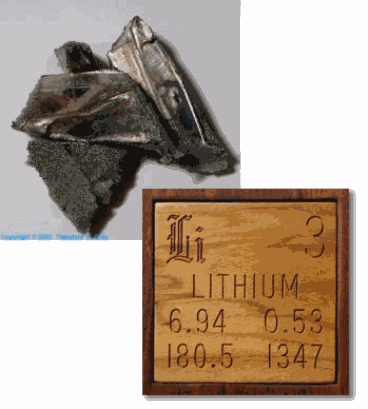At first glance, lithium should be a simple atomic system. It is the lightest solid element and with just three electrons, it should exhibit simple, crystalline structures. However, an international team of scientists has shown that under high pressure, lithium “prefers” the liquid state, and that it turns out to be the elemental metal with by far the lowest melting point. At high pressure, lithium also undergoes a series of phase changes into surprisingly complex structures. The results of these experiments performed at the U.S. Department of Energy Office of Science’s Advanced Photon Source (APS) at Argonne, and at the European Synchrotron Radiation Facility (ESRF) in Grenoble, France, were published Nature Physics.
At ambient conditions, lithium forms rhombohedral crystals, which at higher temperatures and pressures transform to face-centered cubic and then body-centered cubic crystals – all three among the simplest known crystal structures. But what happens to lithium at very high pressures? In the past few years, intriguing deviations from simple metallic behavior were observed, for example a metal to semiconductor-transition and even superconductivity at 17K.
Nevertheless, the overall picture of the lithium phase diagram remained patchy, motivating a systematic study by researchers from The University of Edinburgh, the ESRF, and the Carnegie Institution of Washington who have mapped the lithium phase diagram at high pressures up to 1.3 Mbar, and over a wide temperature range between 77K and 300K.
Whereas the melting point of a material usually rises under pressure, and even the lightest gaseous elements, hydrogen and helium, melt at 1000K and 0.5 Mbar, lithium remains liquid at this pressure down to temperatures as low as 190K. This is by far the lowest melting temperature observed for any material at this pressure.
There are more surprises: Above 0.6 Mbar, lithium adopts three novel, complex crystal structures not previously observed in any element with 40, 88, and 24 atoms per unit cell. The most complex ones, with 40 and 88 atoms, were even never predicted theoretically. The scientists suggest that the overall appearance of the lithium phase diagram and particularly the anomalously low melting temperatures are due to quantum effects starting to play the dominant role at high compressions. They also speculate that a ground metallic liquid state, which has been predicted but never observed for hydrogen, and which should exhibit highly unusual properties, might be constructed on the basis of the lithium-rich compounds.
The experiments were carried out using powder diffraction and single-crystal diffraction at the ESRF High-Pressure Beamline ID09A, and at the High Pressure Collaborative Access Team (HP-CAT) 16-ID-B beamline at the APS, where, in addition, critical cryogenic techniques were refined.
The research team had to address several experimental challenges: handling a diamond anvil cell in a cryostat; ensuring a wide opening angle to allow for single-crystal diffraction; and last but not least, coping with the high reactivity of lithiumm in particular when in the liquid phase.
See: Christophe L. Guillaume1, Eugene Gregoryanz1*, Olga Degtyareva1, Malcolm I. McMahon1, Michael Hanfland2**, Shaun Evans2, Malcolm Guthrie3, Stanislav V. Sinogeikin4, and H-K. Mao3,4, “Cold melting and solid structures of dense lithium,” Nat. Phys., published online: 9 January 2011. DOI: 10.1038/NPHYS1864
Author affiliations: 1The University of Edinburgh, 2European Synchrotron Research Facility, 3Carnegie Institution of Washington
Correspondence: *e.gregoryanz@ed.ac.uk and **hanfland@esrf.fr
The original ESRF press release can be found here.
This work is supported by a research grant from the UK Engineering and Physical Sciences Research Council and facilities made available by the European Synchrotron Radiation Facility. Some of the single-crystal data were collected under ESRF LTP project HS-3090. HP-CAT is supported by the Carnegie Institution Washington, Carnegie-U.S. Department of Energy (DOE) Alliance Center (CDAC), the University of Nevada at Las Vegas, and Lawrence Livermore National Laboratory through funding from the DOE Office of Basic Energy Sciences, DOE-National Nuclear Security Administration, and the U.S. National Science Foundation. Work carried out at HP-CAT was supported as part of the EFree initiative, funded by the DOE Office of Science, under Award Number DE-SC0001057. O.D. acknowledges support from the Royal Society. Use of the Advanced Photon Source, an Office of Science User Facility operated for the U.S. DOE Office of Science by Argonne National Laboratory, was supported by the U.S. DOE under Contract No. DE-AC02-06CH11357.
The Advanced Photon Source at Argonne National Laboratory is one of five national synchrotron radiation light sources supported by the U.S. Department of Energy’s Office of Science, Office of Basic Energy Sciences (DOE-BES). The APS is the source of the Western Hemisphere’s brightest high-energy x-ray beams for research in virtually every scientific discipline. More than 3,500 scientists representing universities, industry, and academic institutions from every U.S. state and several foreign nations visit the APS each year to carry out applied and basic research in support of the BES mission to understand, predict, and ultimately control matter and energy at the electronic, atomic, and molecular levels in order to provide the foundations for new energy technologies and to support DOE missions in energy, environment, and national security. To learn more about the Office of Basic Energy Sciences and its x-ray user facilities, visit .
Argonne National Laboratory seeks solutions to pressing national problems in science and technology. The nation's first national laboratory, Argonne conducts leading-edge basic and applied scientific research in virtually every scientific discipline. Argonne researchers work closely with researchers from hundreds of companies, universities, and federal, state and municipal agencies to help them solve their specific problems, advance America's scientific leadership and prepare the nation for a better future. With employees from more than 60 nations, Argonne is managed by UChicago Argonne, LLC for the U.S. Department of Energy's Office of Science.


